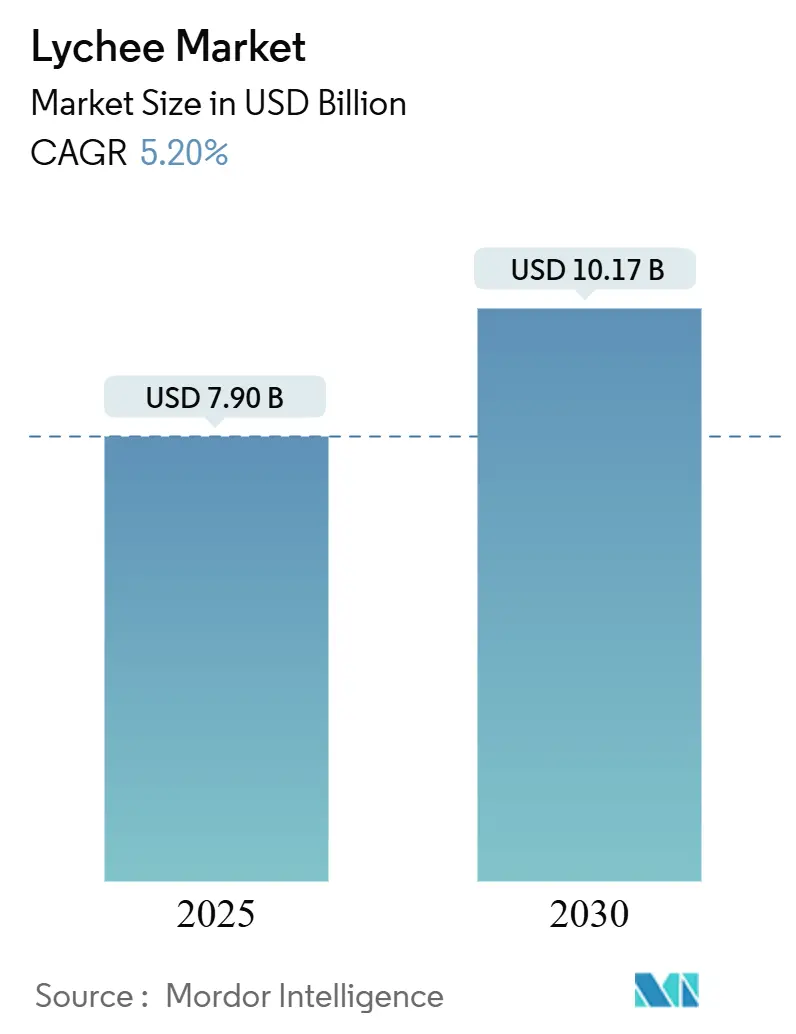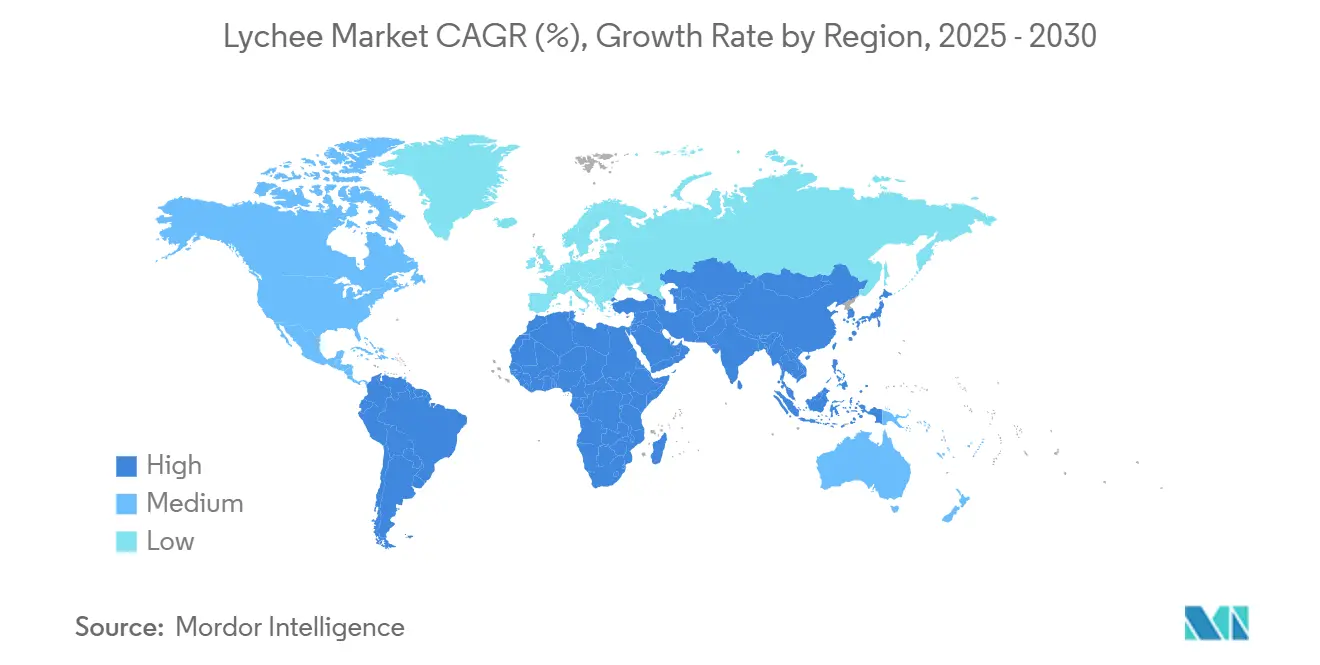Lychee Market Size and Share

Lychee Market Analysis by Mordor Intelligence
The lychee market size stands at USD 7.9 billion in 2025 and is projected to reach USD 10.17 billion by 2030, expanding at a 5.20% CAGR during 2025-2030. Robust consumer interest in exotic produce, continued cold-chain upgrades, and government orchard‐support schemes sustain this upward trajectory. Asia-Pacific keeps its production edge, but African suppliers such as Madagascar now exploit counter-seasonal windows and premium European demand. Commercialization of ultra-early cultivars and the valorization of lychee by-products into nutraceutical and cosmetic inputs are strengthening producer margins. Meanwhile, post-harvest losses and climate-linked yield swings remain structural cost pressures, prompting investment in preservation technologies and integrated pest management.
Key Report Takeaways
- By geography, Asia-Pacific commanded 91.0% of the lychee market share in 2024, while Africa is advancing at a 7.40% CAGR through 2030.
Global Lychee Market Trends and Insights
Drivers Impact Analysis
| Driver | (~) % Impact on CAGR Forecast | Geographic Relevance | Impact Timeline |
|---|---|---|---|
| Rising demand for exotic fruits in high-income economies | +1.2% | North America, Europe, and Middle East | Medium term (2-4 years) |
| Government-backed orchard rejuvenation programs | +0.8% | China, India, Thailand, and Vietnam | Long term (≥ 4 years) |
| Rapid expansion of cold-chain logistics | +1.0% | Global, centered in Asia-Pacific and Europe | Medium term (2-4 years) |
| Increasing use of lychee extracts in nutraceuticals and cosmetics | +0.7% | Global, led by North America and Europe | Long term (≥ 4 years) |
| Commercialization of ultra-early maturing cultivars | +0.5% | China, Australia, and Israel | Short term (≤ 2 years) |
| Carbon-credit incentives for agro-forestry lychee projects | +0.3% | Global, early adoption in Mediterranean zones | Long term (≥ 4 years) |
| Source: Mordor Intelligence | |||
Rising demand for exotic fruits in high-income economies
Lychees have moved from niche ethnic shops to mainstream retail in the United States and Europe. Seasonal peaks around Christmas and Easter double baseline volumes, sustaining premium prices. Madagascar supplies 80% of Europe’s intake and commands mark-ups 30-40% above Asian freight-inclusive offers. Strict pesticide-residue limits and size grades (≥ 33 mm for Extra Class) favor experienced exporters with audited quality systems. Retailers bundle lychees into wellness-oriented fruit mixes, increasing visibility among health-conscious consumers. This dynamic broadens the lychee market beyond expatriate communities and underpins revenue growth for integrated packers.
Government-backed orchard rejuvenation programs
China, India, Thailand, and Vietnam channel subsidies toward orchard replanting and drip-irrigation upgrades, trimming smallholder cash constraints. A 10% subsidy rise lifted Chinese farmers’ market participation by 0.15%, signaling efficiency payoffs. In the United States, the Marketing Assistance for Specialty Crops program raised per-producer support, defraying high marketing costs.[1]Source: U.S. Department of Agriculture, “Notice; Marketing Assistance for Specialty Crops,” Federal Register, federalregister.gov These funds accelerate varietal renewal and post-harvest tech adoption, positioning beneficiaries for superior yields and export compliance. Producers outside subsidy coverage risk lagging on quality and scale, potentially narrowing their competitiveness within the lychee market.
Rapid expansion of cold-chain logistics
Shelf life extension from 7 days to as much as 39 days via gamma irradiation, chitosan-based membranes, and Phase-Temperature Storage is altering cost equations. PTS systems slash energy use by 96% while keeping pericarp brightness. These breakthroughs lower air-freight dependency, support sea modes, and thus broaden reach to North America and the Middle East. Retail chains reward suppliers with uninterrupted cold-chain integrity through multi-year contracts, fostering technology uptake among exporters keen on securing stable off-take.
Increasing use of lychee extracts in nutraceuticals and cosmetics
Producers now monetize pericarp and seed residues, which represent 15-20% of fruit mass, by extracting flavanol-rich compounds. Encapsulated oligomeric procyanidins show 90.92% stability, suiting anti-oxidative skincare lines. Clinical studies link lychee extracts to improved uric acid metabolism and oxidative stress markers. These ancillary revenue streams cushion price volatility in the fresh segment and stimulate investment in processing capacity within the lychee market.
Restraints Impact Analysis
| Restraint | (~) % Impact on CAGR Forecast | Geographic Relevance | Impact Timeline |
|---|---|---|---|
| Short post-harvest shelf life despite improved packaging | -1.5% | Global, impacting long-distance trade | Short term (≤ 2 years) |
| High susceptibility to fruit borer and downy blight | -1.1% | Asia-Pacific production regions | Medium term (2-4 years) |
| Volatile farm-gate prices due to weather-linked bumper crops | -0.8% | China, Vietnam, Thailand, and India | Short term (≤ 2 years) |
| Limited varietal uniformity limiting large-scale mechanization | -0.6% | Global production zones | Long term (≥ 4 years) |
| Source: Mordor Intelligence | |||
Short post-harvest shelf life despite improved packaging
Even with state-of-the-art packs and 2-4 degrees Celsius storage, pericarp browning accelerates once cold-chain breaks occur, leading to 25-30% losses in producing hubs. Insurance premiums and rejection rates inflate exporters’ costs smaller traders exit the lychee market, deepening consolidation around players with integrated temperature-controlled networks. The constraint is acute in Africa and parts of Southeast Asia, where grid instability complicates continuous refrigeration.
High susceptibility to fruit borer and downy blight
Fruit and shoot borers destroy up to 48% of yields in unmanaged orchards, while downy blight slashes output by 10-30% in typical years and 80% in epidemics.[2]Source: Pankaj, “Fruit Borer Folder,” ICAR-National Research Centre on Litchi, nrclitchi.icar.gov.in Export markets tightening residue limits curtail chemical options, raising the bar for integrated pest management. Biological controls like Anastatus japonicus help, yet require farmer training and monitoring hardware. Uneven adoption widens quality gaps and complicates bulk sourcing for global retailers.
Geography Analysis
Asia-Pacific generated 91.0% of global output in 2024. China’s 2025 crop is projected at 1.6 million metric tons, with western provinces contributing 1.03 million metric tons.[3]Source: Guangdong Provincial Government, “Guangdong's lychee production is expected to reach 1.6 million tons this year” gd.gov.cn Digital technologies, such as remote-sensing irrigation notifications, enhance yield reliability and increase farmer earnings by 17% in test plots. Aging orchards and labor scarcity push growers toward semi-mechanized pruning and harvesting aids. Vietnam’s climatic shocks illustrate vulnerability. Excessive rainfall halved Bac Giang output in 2025, though prices surged to protect farm revenues.
Europe remains a significant import market for the product. Retailers prioritize GlobalGAP and pesticide-light supplies. Organic volumes are set to expand as the European Green Deal phases in stricter agro-chemical caps. Seasonal consumption spikes during the December holidays underpin stable containerized trade flows. North America's acreage has increased substantially over recent years. Florida’s ‘Hak Ip’ and ‘Kaimana’ cultivars target East Coast Asian grocery chains and emerging e-commerce platforms.
Africa is the fastest-growing zone at 7.40% CAGR to 2030, led by Madagascar, whose counter-seasonal December harvest supplies 80% of Europe’s demand. Middle Eastern demand builds on expatriate populations and premium gifting culture, with Gulf retailers importing air-freighted Thai and South African fruit for high-end malls.

Recent Industry Developments
- July 2025: Vietnamese lychees entered Costco stores in the United States in June 2025, representing a significant advancement for Vietnam's fresh fruit exports. This market entry builds upon Vietnam's established lychee exports to Japan, Australia, and the European Union, particularly for produce from the Bac Giang region.
- June 2025: India achieved a milestone in horticultural exports with its first shipment of rose-scented lychee from Pathankot, Punjab, to Doha, Qatar. Food Products Export Development Authority (APEDA), in collaboration with local stakeholders, facilitated this export initiative. This development establishes Pathankot's position as a significant producer of premium lychee with access to international markets.
Global Lychee Market Report Scope
Lychee is the sole member of the genus Litchi in the soapberry family, Sapindaceae, grown for its edible fruit. For analysis, only fresh produce is considered, and any form of processed produce is excluded from the scope. The lychee market is segmented by geography into North America, Europe, Asia-Pacific, and Africa. The report provides an analysis of production (volume), consumption (volume and value), import (volume and value), export (volume and value), and price trend analysis. The report offers the market size and forecasts for value (USD) and volume (metric tons) for all the above segments.
| North America | United States |
| Canada | |
| South America | Brazil |
| Europe | Spain |
| France | |
| Asia-Pacific | China |
| India | |
| Thailand | |
| Vietnam | |
| Middle East | United Arab Emirates |
| Qatar | |
| Africa | South Africa |
| Madagascar |
| By Geography (Production Analysis (Volume), Consumption Analysis (Volume and Value), Import Analysis (Volume and Value), Export Analysis (Volume and Value), and Price Trend Analysis) | North America | United States |
| Canada | ||
| South America | Brazil | |
| Europe | Spain | |
| France | ||
| Asia-Pacific | China | |
| India | ||
| Thailand | ||
| Vietnam | ||
| Middle East | United Arab Emirates | |
| Qatar | ||
| Africa | South Africa | |
| Madagascar | ||
Key Questions Answered in the Report
How large is the lychee market in 2025?
The lychee market size is USD 7.9 billion in 2025.
What is the forecast CAGR through 2030?
Market value is projected to expand at a 5.20% CAGR during 2025-2030.
Which region dominates lychee market?
Asia-Pacific accounts for 91.0% share of the lychee, with China being major contributor.
Why is Africa attracting attention?
Madagascar's counter-seasonal harvest feeds European demand, driving a 7.40% regional CAGR.
Page last updated on:

